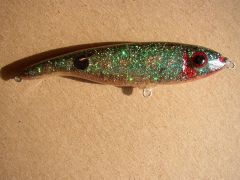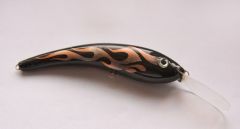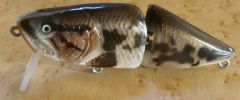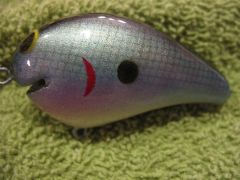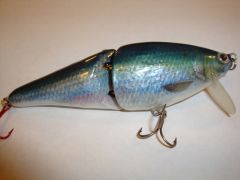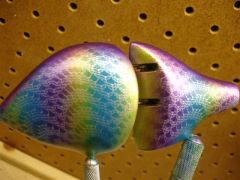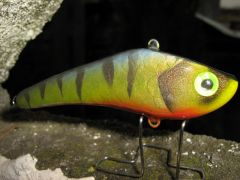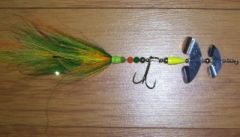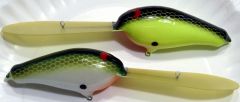-
Posts
3,867 -
Joined
-
Last visited
-
Days Won
23
Content Type
Profiles
Articles
TU Classifieds
Glossary
Website Links
Forums
Gallery
Store
Everything posted by diemai
-
-
-
@ pikeman Back in school art lessons , more than 30 years ago , we have made prints by carving the negative into artificial floor sheets made of something called "linoleum" . We were carving it with ordinary wood whittling chisels . But I guess , that would be a very finacky work to make a stamp for such a small thing like the signature on a lure , also you could only use it on plane surfaces , not too curved ones . good luck , diemai
-
@ knifemaker3 Did you check http://www.mooreslures.com ? Don't know about pricing of bucktails , but with other lure components that shop used to be cheaper . greetz:yay: , diemai
-
@ SmokeyJ I haven't considered about that , sorry ! Guess there won't be nothing left to do but try the glitter flakes in the dips solvents first , and if they do dissolve , one needs to chance the method/laquer or the glitter flakes for glitter plating . @ Jio Maybe you can say something to it ? You have already mentioned , that it was metallic glitter , but is it REALLY metal ? I am not so sure anymore after Smokey's statement ! @ rofish To me that glue looks like ordinary woodglue with it's white color , such glue does not bind with metall , usually . I would at least use an allround glue , if not my two-component glue . I have a few of those handmade Finnish lures , the smaller ones are indeed made to fish for salmon and trout . But consisting of balsa you would wonder about their rigidity , especially their rock hard surfaces , that really do reinforce the balsa . A lure , that was designed and built for pike fishing , won't get destroyed even by the biggest one ! Believe me , the Finnish know , what they are doing about their luremaking , brand names like "Rapala" , "Nils Master" and "Turus Ukko" are evidence enough to me . greetz:yay: , diemai
-
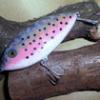
My second swimbait (better than the first ^^)
diemai commented on JoE_f!shEr's gallery image in Hard Baits
-
@ SmokeyJ Sorry , haven't used this methods of dipping before , but I am quite sure that no dip nor cleargloss of whatever kind would damage those glitter flakes , they are just very tiny pieces of metal , aren't they:? ? @ Jwags Obviously the guy is using a metal saw blade , as Jio stated . I have tried to cut balsa before with an ordinary woodsaw , seemingly the teeth are too large/rough for the soft material , they bite into it , you use more force and as a result the edges of the cut become improper , not clean and woodgrain tears away ! That fine-toothed metal saw blade is much better suited for balsa , it may take some more time , but the cuts are clean . @ Jio Nice , that you have joined this thread , being one of those skilled Finnish lurecarvers:) ! greetz:yay: , diemai
-
@ Milia B At first , welcome in the forums in here ! I am not in the USA , so I can't give you any suggestion about brand names , but your choice surely would depend on the work , that you intend to do , also on your bugdet , off course . For instance , if you want to work with softer , lighter woods , you would not need the most powerful and rigid model , for hardwoods you'd need something stronger , with more rigid center tips , bearings , chisel rest , etc....! Also it depends on the size of your planned workpieces , I know that in Germany there is a model available , that would not be suitable for bigger lures , since the distance between the two center tips is only about 12" , and the chisel rest is also quite narrow . Turning longer workpieces on it would be not as convinient , since one always would have to change the position of the chisel rest along the length of the workpiece , also hardwoods might constantly take it to its limits . So , if the budget is not such a great issue , I'd always go for something bigger and stronger , for turning down bigger musky and saltwater plugs exclusively a center tip distance maximum of 20" should be sufficient , but if you also want to also turn furniture parts , it still needs to be bigger . There are tutorials about lathe turning in here , you may utilize the search function to find them ! good luck:yay: , diemai
-
-
-
@ RiverMan Do you mean , that you can't get the video ? Just tried it again with above links , it works for me ! greetz:yay: , diemai
-
-
@ rofish I don't have sound to it either , but the way the wood looks and acts when cutting it , I am 100% sure , that it is medium dense balsa , all of the homemade Finnish lures , that I have swapped with guys from over there , are made of it , anyway . I am also amazed about the simplicity of the working process , and luckily I own a few results of that , you probably could already call it folk art , Finnish lurecarving . greetz , diemai
-
@ JBlaze Check this out : Grandma Crankbaits Your "no action" problem is exactly the same , what I have experienced with that balsa lure I mentioned in my first reply to this thread:yes: . @ jamie You are right about playing with that weight , not an easy task in my opinion . I understand , that the bait would not be supposed to lay flat on its side , maybe I have used the wrong words in English , sorry ! I guess , that the weight must be somewhere in the front portion of the lure , on a "Grandma" style this would be the highest body portion , so the effect of the weight would be more pronounced there . I also think , that a smaller , downward lip would enhance your desired effect(at least not be counterproductive) , whereas a pointing forward , deep diving bill would act as a stabilizing rudder AGAINST sideward tipping . In my early days of crankbait making I have also found , that a line tie , placed close , or even right onto a downward pointing , shallow diving lip , causes the lure to lay on its side or even blow out . If weighted properly , it might still work reasonably at slow speeds , but faster reeling would cause it to lay flat and break out from it's straight course . I guess , this is , what you call "hunting" ? The "V" cross section is not my own theory , got it from a Swedish origined crankbait making book(German translation) , which has become kinda "bible" of German lurecarvers through the past years . greetz:yay: , diemai
-
@ jamie I have made similar lure rattles out of 8 X 0,5 mm brass tubing , filled with two 4 mm steel balls . Have placed these crosswise in about the fattest part of the lurebody(more or less in the center of gravity) , into rather flat sided but also round bodied lures alike , about 3 1/2" to 5" in length . I could not observe any significant sideward break outs . It was not my intention , anyway , I only wanted a rattle in my lures . To achieve your described features , I guess that such casings have to be filled with sufficient weight , also placed above the center of gravity to be able to achieve a certain amount of leverage to cause the lure to swing more to the sides and thus to probably achieve this hunting action . The higher the weight would sit in the lure body , the lest weight would be needed , due to more leverage further upward from the center axis of the lure . The wider the weight could move towards the sides of the lurebody , the more leverage it would also provide . In result the lurebody must not be too narrow at its back portion to accommodate such a little longer crosswise casing . But on the other hand a "V" shaped cross section of a lure body(back pointed , belly wider) is the most unstable body design with the highest tendency to capsize , if not properly counterbalanced . So maybe this would be the design to go for:? ? But also I believe , that the whole thing stands or falls with the size , volume and buoancy of the lure . I guess , if it was too large , a little swinging weight won't take it out of balance too much . Just a few thoughts:?.....greetz , diemai
-
@ parrothead127 Welcome to Moore's Lures has a prop in his PDF catalog , page 27 , said to be manufactured in the early 1940's , also fitting washers , bought some a few years ago . greetz:yay: , diemai
-
@ Jwags I don't know much about rod building , so far I only did some crudely furnished repair jobs without any sense for beauty . But I remember one ocassion , years ago , when one guy , that I knew , set the hook on a bite with his brandnew 300 Deutschmarks(those days no Euros yet) two piece carp rod and it broke apart . When checking the damage we have found , that the female bottom portion of the ferrule had just split up . There were no reinforcing windings on the end of the bottom section , don't know , whether by intention or Shimano just forgot it , he had claimed warranty and he got it , anyway ! But since on my repair jobs I haven't failed to make these reinforcements , tought me a lesson ! good luck:yay: , diemai
-
@ woodieb8 If this could be of any help : Some years ago I have repainted an approx. 6" deep diving "Fingerling" , scraped and sanded off all of the original pattern(or what was left of it:lol:) , the plastic underneath did not seem to be hollow and made of two halves , but solid , it had a kind of ivory color . greetz:yay: , diemai
-
Someone has posted these videos part 1+2 on a German luremaking site . Looks very interesting to me , especially the foiling between two sponges and the glitter plating in a glass jar . Guess , that I even own a lure made by this guy , swapped with Finnish friends , since it looks much like one hanging in his drying rack . Part 1 : YouTube - Making Wobblers by hand Part 1 Part 2 : YouTube - Making Wobblers by hand Part 2 Enjoy:) ! greetz , diemai
-
@ jamie Never considered this topside weights as a method to tune lures to a more pronounced flanking action , but just as a method to finally get them goin' , when nothing else helps . Not much heard of over here , as it seems........ I came across it first time some years ago in a Swedish origined luremaking book . But probably one should try this way of weighting more often with newly made lures , some lure shapes would accept it , some won't , but certainly resulting into little different swimming patterns , that could make the difference in pressured waters . greetz , diemai
-
You have ovbiously employed the same method of glueing on the single scales like you did on your first upload ! Are these of aluminium foil as well or you have used a different material , since you have painted over it , anyway ? But the lure turned out very nice looking with those scales again and that perch pattern ! greetz:yay: , diemai
-
@ jamie Once got a 6" balsa blank from some guys in Finland in terms of a lure swap . It was a knock-off of a "Nils Master Invincible" , but yet still a little wider(more oval) in body cross section than the original lure . When first testing the assembled and unpainted lure in my bath tub , I had to tape on tons of lead to its belly to get it to dive without popping back up rapidly , since it was just too buoyant . All of this "keel weight" spoilt the wiggling action , so I have thought about taking some leadshot away from the belly and put it on the top side of the blank and it worked out perfectly , so I could drill holes and glue in the weights . I have fished that lure a few times since , it has a perfect wiggling action . But this was the only occasion so far , that I did this topside weighting thing , but without a doubt it is one of the few options , that one has to get an "unwilling" lure working at last ! greetz , diemai
-
Even I don't know much about buzzbaits , I like the design of the green/chartreuse one best:yes:(simply , because it is the shortest) ! I bet , these two counterrotating props would generate ahelluva noise ! Through the years I have swapped some bucktail spinners , and I experienced , that the longer these are , the worse their casting performance is . Due to registrations over here we can't use boats that much to get to the fish , but need to cast from bank to where they are , so much about my concern about casting performance . well done , diemai
-
@ combat If this could be of help ??? The German tackle,-and component supplier HAKUMA ihr Spezialist für Köder, Kunstköder, Meeresangeln, Raubfisch angeln, Pilker, Wobbler, Fischen, Bleiguss, Formen, Ruten, Rollen, Dorsch angeln, Leng angeln in Norwegen, Dänemark, Hitra sells alloyed lead ingots for lure casting . They state in their printed catalog 2006/2007 issue(don't have a recent one) , that this alloy consists of 12% Antimon(sorry , don't know the English for it , suppose it's a chemical element and/or metal ?) and 2% pewter/tin("Zinn" in German) . The melting point is a bit lower than pure lead , stated 250° Celsius , also it does not shrink as much in the mold when chilling down after casting , they also write in their catalog . I have used this alloy a few times for casting leadheads and jigging spoons , the stuff does not tarnish like ordinary lead , but keeps its silvery surface . It is also more rigid , meaning that no deep blemishes would show up , when tossing the leadheads or jigging spoons roughly along rocky bottoms , thus the paint coats of the lures don't come off as easily . The 1000 grams ingots(haven't bought the 12000 grams ingots before) are shaped like a square chocolate bar , with grooves to break smaller pieces off , which really works with that alloy ! Just put it on a concrete floor , grooves downward and hit the back of the groove with the pointed end of a hammer , if you hit it right , it would break , not just deform like ordinary lead . good luck:yay: , diemai
-



